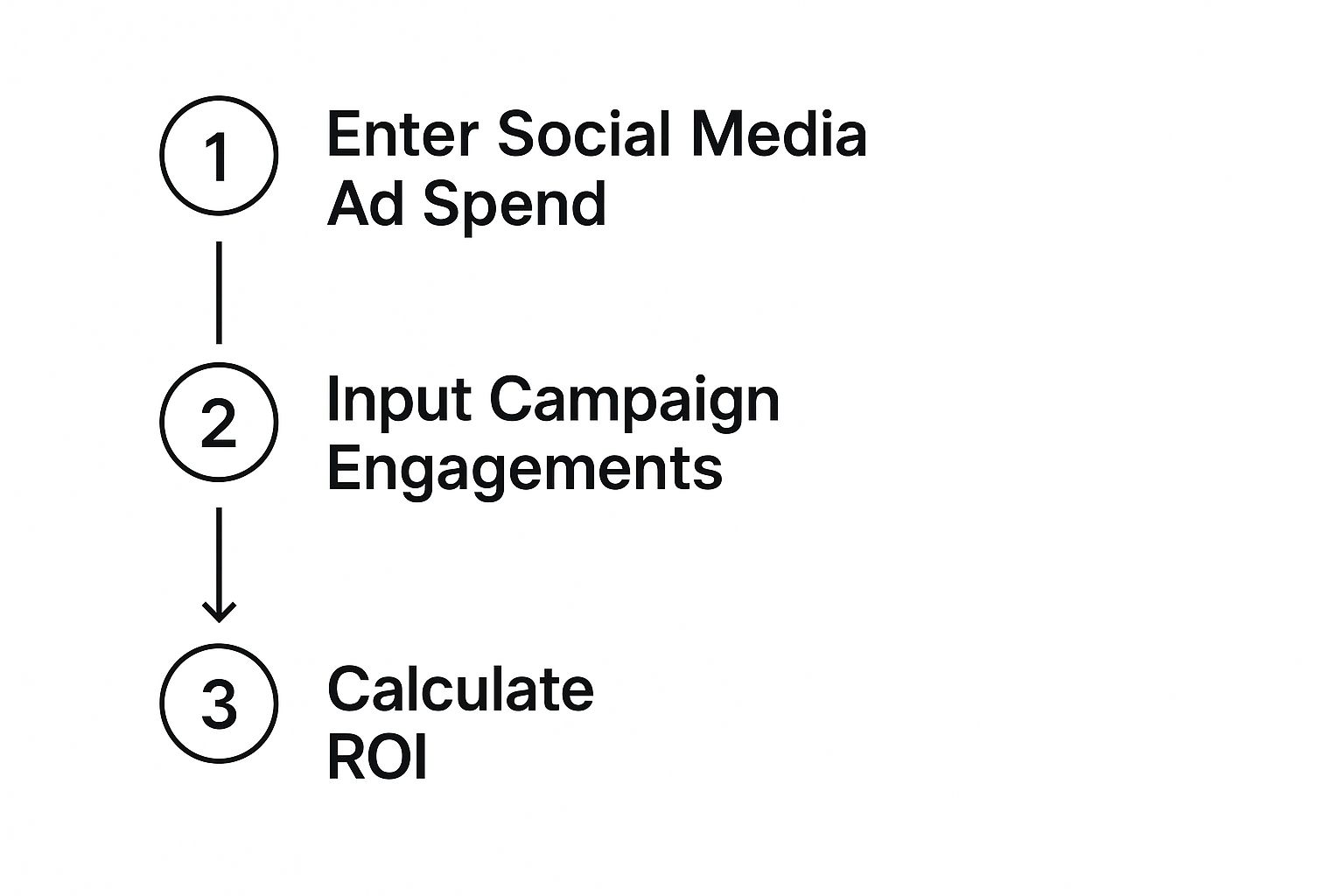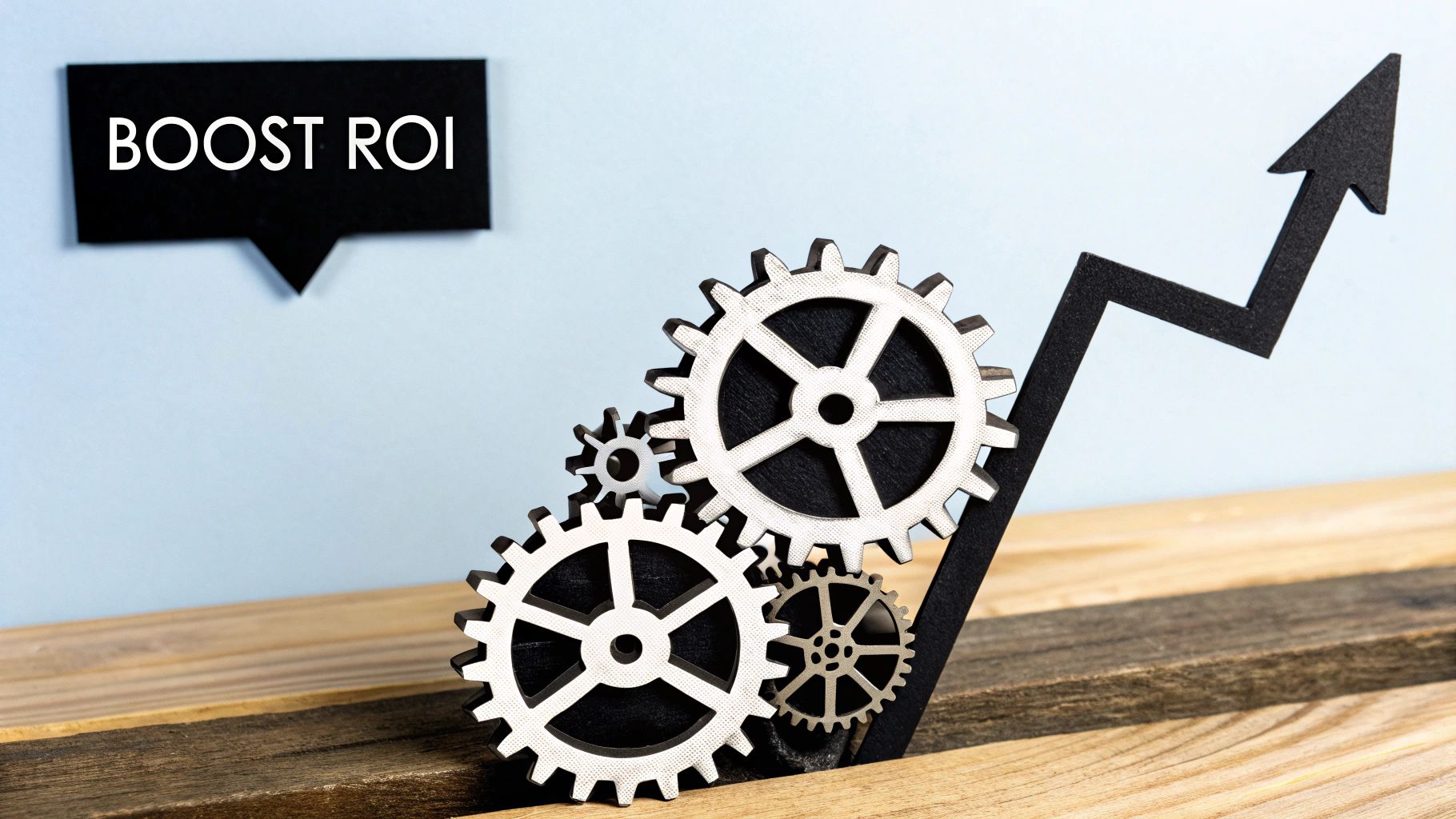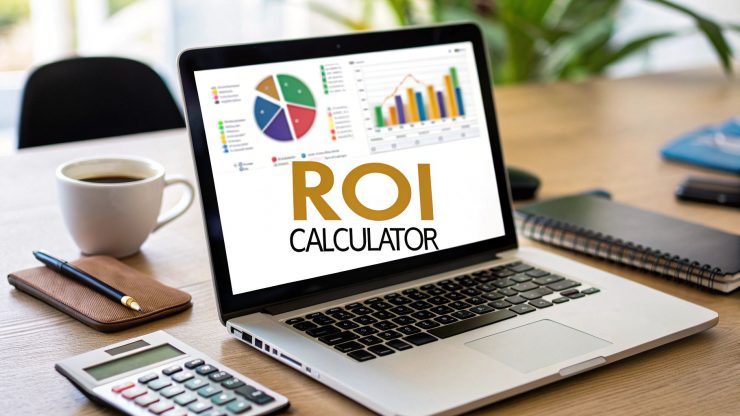A social media ROI calculator does one thing really well: it translates all your hard work on social media into a clear financial result. It's a tool that moves you past simply tracking likes and shares and forces you to connect your team's daily grind to actual business goals. This is how you justify budgets and get the green light to double down on what's working.
Moving Beyond Likes to Real Financial Impact

Let's be honest—proving the financial worth of your social media efforts can feel like an uphill battle. For years, marketers have relied on vanity metrics like follower growth, likes, and shares to show success. While those numbers are great for gauging engagement, they don’t always satisfy the C-suite, who rightfully want to see a tangible return on their investment.
This is where the conversation needs to shift from just being busy on social media to being effective. The real goal isn't just posting content; it's driving business outcomes. That means connecting every dollar spent and every hour worked to a concrete financial result.
From Vague Metrics to Tangible Value
A social media ROI calculator is what bridges that gap between your marketing activities and the company's bottom line. It makes you move beyond fuzzy metrics and focus on what really moves the needle. Instead of just reporting a high engagement rate, you can confidently show how that engagement directly translated into new leads, closed sales, or a higher customer lifetime value.
By translating social media metrics into the language that executives understand—dollars and cents—you elevate your role from a content creator to a strategic business driver. This shift is crucial for securing budget, building trust, and proving your team's value.
Making this transition isn't just about better reporting; it’s a fundamental change in how you approach your strategy. It demands a crystal-clear understanding of what you're putting in and what you're getting out.
To do this right, you first need to get a handle on all the data points you'll be plugging into the calculator. This simple table breaks down what you'll need to gather (Inputs) and what you'll get back in return (Outputs).
Inputs and Outputs of a Social Media ROI Calculator
| Metric Type | Example Data Point | Purpose |
|---|---|---|
| Input | Total Ad Spend | The direct cost of paid campaigns on platforms like Facebook, LinkedIn, etc. |
| Input | Team Salaries/Labor Costs | The portion of your team's salaries dedicated to social media. |
| Input | Tool & Software Costs | Monthly/annual fees for schedulers, analytics, and design tools. |
| Input | Content Creation Costs | Expenses for photoshoots, video production, or freelance writers. |
| Output | Revenue from Social | Sales generated directly from social media channels (tracked via UTMs). |
| Output | Value of Leads Generated | The monetary value assigned to each lead acquired through social media. |
| Output | Customer Service Savings | Cost savings from resolving customer issues via social vs. call centers. |
Understanding these inputs and outputs is the foundation of an accurate ROI calculation. Once you meticulously track these elements, the calculator provides a clear, defensible number that demonstrates the true impact of your work.
Identifying the Metrics That Actually Matter

Before you can even think about plugging numbers into a social media ROI calculator, you have to be sure you’re tracking the right things. An accurate calculation is only as good as its inputs. It’s all about separating the signal from the noise and focusing on metrics that tie directly back to your core business goals.
The whole process really comes down to two key components: your Investment and your Return. Getting these right is absolutely non-negotiable if you want a result that means something.
Defining Your Total Investment
Your investment is so much more than what you're spending on ads each month. This is one of the most common mistakes I see people make—they forget the hidden costs, and their ROI ends up looking artificially high.
To get a true picture, you need to account for everything:
- Ad Spend: This is the obvious one—the direct cost of your paid campaigns on Facebook, Instagram, LinkedIn, and so on.
- Team Hours: Think about the salaries of your social media manager, content creators, and designers. You need to calculate their hourly rate and multiply it by the time they genuinely spend on social media work.
- Content Creation Costs: Did you hire a photographer for a shoot? Pay for video production? Work with an influencer? All those external expenses count.
- Tools and Software: Don't forget the monthly or annual fees for your scheduling platforms, analytics tools, and design software. It all adds up.
By tallying these costs, you get a complete, honest look at what you’re actually spending. This number becomes the "Cost" side of your ROI equation.
Pinpointing Your Tangible Return
Next up is the "Return." This is where you have to put a real dollar value on the results your social media efforts are generating. It’s time to look past vanity metrics like likes and followers and focus on actions that directly impact the bottom line.
Don’t just track clicks; track what happens after the click. A thousand clicks that lead to zero sign-ups are worth far less than ten clicks that result in five high-quality leads. The goal is always to connect social activity to a real business outcome.
So, what does this look like in the real world?
- Lead Generation: Let's say a LinkedIn campaign drives 50 sign-ups for your webinar. If you know from experience that each qualified lead is worth about $100 to your business, your return from that campaign is $5,000.
- Direct Sales: You ran an Instagram Stories ad campaign and used UTM parameters to track everything meticulously. It generated $15,000 in e-commerce sales. That’s your direct return, clear as day.
- Customer Lifetime Value (CLV): Maybe you discover that customers who come from Twitter have a 25% higher CLV than those from other channels. That long-term value is a crucial part of your return and needs to be factored in.
Making sure these metrics align with your business goals is everything. For example, a common benchmark in paid social campaigns is aiming for a return that's two to three times your investment. For every $1 you spend, you're looking to generate $2 to $3 in revenue. If you want to dive deeper into these industry standards, you can see how to calculate returns on paid campaigns with Popular Pays.
Ultimately, when you choose the right metrics, your final ROI figure isn't just a number—it’s a powerful story about how much your social media is truly contributing to the business's financial health.
How to Calculate Your Social Media ROI
Alright, let's get down to the brass tacks. The actual formula for social media ROI isn't complicated, but its usefulness hinges entirely on feeding it the right numbers.
The classic formula is: (Net Profit / Total Investment) x 100. Simple enough, right?
But to really understand it, let's ditch the theory and walk through a scenario I see all the time. Imagine a small e-commerce shop that sells custom-printed t-shirts. They decide to run a campaign on Facebook and Instagram to push a brand-new design.
First, Tally Up Your Total Investment
This is where a lot of people trip up. They only count the ad spend, and that gives them a wildly inflated, inaccurate picture of their return. You have to account for everything.
Here’s what our t-shirt brand’s real investment looks like:
- Ad Spend: The money paid directly to Meta to run the ads. Let's say that was $500.
- Creative Costs: They paid a freelance designer to make the ad visuals look sharp. That cost $400.
- Copywriting: They hired a pro to write ad copy that converts. Another $300.
- Team Time: The social media manager spent about 10 hours on this—from setup to monitoring to reporting. At an internal rate of $50/hour, that's a $500 labor cost.
Add it all up, and the Total Investment wasn't just $500; it was $1,700. See the difference? If you want to dig deeper into which costs you should be tracking, we cover all the crucial metrics in our full guide on how to measure social media ROI.
Next, Figure Out Your Net Profit
Now for the fun part—the money you made back. The campaign did well, driving a good amount of traffic and generating $3,500 in revenue from t-shirt sales.
To get the Net Profit, we simply subtract our total costs from the revenue.
$3,500 (Revenue) – $1,700 (Total Investment) = $1,800 (Net Profit)
This whole process—from tallying costs to calculating the final return—is a straightforward flow. It’s all about connecting what you spent to what you earned.

As you can see, it's a logical path from inputs to outcomes. Now, let's plug our numbers into the full ROI formula.
Here's the math for our t-shirt company: ($1,800 Net Profit / $1,700 Total Investment) x 100 = 105.8% ROI. This tells us that for every single dollar they put into this campaign, they got that dollar back plus an extra $1.06 in pure profit.
That positive ROI is a green light. It’s a clear signal that the campaign was a financial win and gives the team a solid reason to consider scaling this strategy. When you're dealing with multiple campaigns and a mess of different costs, using a dedicated social media ROI calculator can save you a ton of time and headaches.
Finding the Right Calculator for Your Team
Look, you can absolutely calculate your ROI by hand. It’s a great way to get your head around the basic formula. But let’s be honest—when you’re managing multiple campaigns across a half-dozen platforms, a spreadsheet quickly becomes a nightmare. This is exactly where a good social media ROI calculator stops being a nice-to-have and becomes essential.
Switching from a spreadsheet to a dedicated tool is like going from a paper map to Google Maps. Sure, both can get you from A to B, but one gives you real-time traffic, alternate routes, and a whole lot more context to make a better decision. ROI calculators do the same; they handle the heavy lifting so you can focus on strategy.
You’ll find plenty of options out there. Some are free, simple web tools that are perfect for a quick, back-of-the-envelope calculation. On the other end of the spectrum, you have robust software that plugs directly into your social accounts, pulling data automatically and giving you a live look at your performance.
What to Look for in a Great Calculator
Over the years, I've tried a lot of these tools, and I've learned that the best ones do more than just spit out a percentage. They help you understand the why behind the numbers.
Here’s what I always look for:
- Pulls Everything Together: The tool absolutely has to connect with all your channels—Facebook, LinkedIn, TikTok, you name it. You need one place to see the complete picture, not a dozen different tabs.
- Accounts for Real Costs: A great calculator lets you input more than just your ad spend. Think about the costs for content creation, your team's time, and the other tools you pay for. True ROI includes all of it.
- Gives You Actionable Reports: The output should be easy to understand. I want to see clear, visual breakdowns that let me compare performance by campaign, channel, and even by individual post.
The goal isn't just to answer, "What was our ROI?" The real question is, "Why was it what it was?" A top-tier tool helps you see which campaigns are hitting home runs and which are just wasting your budget, so you can make changes on the fly.
Unlocking Deeper Performance Insights
The real power of modern ROI tools is in the details they provide beyond that one big number. A quality calculator can instantly tell you your cost-per-engagement or cost-per-lead and break it down for each campaign.
This is where the magic happens. Imagine discovering your Instagram campaign has a higher overall ROI, but your LinkedIn ads are actually bringing in leads for half the price. That’s a powerful insight that tells you exactly how to adjust your budget next quarter.
Today's calculators are built to provide this kind of nuanced understanding. For instance, many tools let you input everything from ad spend to organic engagement metrics like likes and shares across all your networks. They then produce detailed reports, often with visual charts, so you can put campaigns side-by-side and see your cost-per-conversion at a granular level. If you want a closer look at what this looks like in practice, you can learn more about how these advanced calculators work at Business Initiative.
Picking the right tool gives you the confidence to know you're putting your money where it will make the biggest impact.
Turning Your ROI Results Into Actionable Strategy

Figuring out your ROI is a huge first step, but the number itself is just a starting point. The real magic happens in what you do with that information. A figure from a social media ROI calculator isn’t just a pass-fail grade; it’s a compass pointing you exactly where you need to focus your efforts.
Whether your ROI is through the roof or stuck in the basement, the result always lights up a clear path forward. It’s all about turning that percentage into a real-world game plan for your next campaign.
When Your ROI Is Strong
Seeing a positive ROI is obviously a great feeling. It’s confirmation that you’re on the right track. A result like 178% doesn't just mean the campaign made money; it means you’ve hit a sweet spot with your creative, audience, and platform choice. Your immediate job is to figure out why it worked so you can do it again, but bigger.
Don't just pop the champagne and move on—dig into the data. Start asking questions:
- Which platform was the MVP? If your Instagram ads blew everything else out of the water, it’s probably time to shift more of your budget in that direction.
- What type of content connected most? Did your short-form videos completely outperform static images? That's a strong signal to lean into video creation.
- Who was your most engaged audience? Get granular with your analytics. See which specific demographics, locations, or interest groups were converting the most.
A positive ROI is your green light to double down. Pinpoint the top-performing parts of your campaign and start scaling them methodically. This is how you transform one successful campaign into a dependable growth engine for your business.
Troubleshooting a Low or Negative ROI
Let's be real—seeing a low or negative ROI stings. But it isn't a failure. It's just feedback, and it's incredibly valuable. A poor result tells you there's a disconnect somewhere between what you’re spending and what you’re getting back. Now you get to play detective and find the weak link in the chain.
The best way to start is by working backward from the point of conversion. Run through this checklist to diagnose what might have gone wrong:
- Check Your Landing Page: Your social ads could be amazing, but if they send people to a clunky, confusing, or slow-loading landing page, you're just burning money. Look at the page’s bounce rate and time-on-page in your analytics. Is it mobile-friendly?
- Review Your Ad Creative and Copy: Is your message crystal clear? Does the visual actually stop someone from scrolling? You need to A/B test different headlines, images, and calls-to-action to find what clicks with people.
- Analyze Your Audience Targeting: Are you absolutely certain you're reaching the right people? Your offer could be perfect, but if you’re showing it to an audience that doesn't care, it’s going to flop. Revisit your targeting settings and consider building lookalike audiences from your best customers.
Treating a negative ROI as a lesson is crucial. Every piece of data helps you get smarter and avoid making the same costly mistakes twice. For a deeper dive into course-correcting, our guide on how to improve your social media strategy offers some fantastic, actionable tips. This cycle of analyzing, tweaking, and optimizing is what truly separates the pros from the amateurs.
Common Questions About Social Media ROI
Even with a solid plan and a great social media ROI calculator, a few questions always pop up. It's completely normal—ROI isn't always a neat, tidy number, especially when you're dealing with the moving target that is social media. Let's clear up some of the most common points of confusion so you can feel confident in your numbers.
So, how often should you actually run these calculations? There’s no single right answer, but a quarterly deep-dive is a fantastic rhythm for most businesses. This timeframe gives your strategies enough breathing room to actually produce meaningful data.
Of course, if you’re running a specific, high-stakes campaign with a clear start and end date, you'll want to do a full analysis within a week or so of it wrapping up.
How Do You Measure the Value of Brand Awareness?
This is the million-dollar question, isn't it? How do you assign a concrete value to something as fuzzy as brand awareness or community building? These things don't come with a direct sales receipt, but we all know they're incredibly valuable. The trick is to focus on proxy metrics that tell the story of your growing influence.
Instead of chasing a direct dollar figure for awareness, track these indicators:
- Share of Voice (SOV): How much of the conversation in your industry revolves around you versus your competitors? When your SOV goes up, your brand's footprint is expanding.
- Audience Growth Rate: A steady, organic increase in followers is a clear sign that your message is hitting home with new people.
- Sentiment Analysis: What’s the general vibe of the conversation around your brand? Tracking whether mentions are positive, negative, or neutral is crucial. Positive sentiment is an invaluable asset.
By monitoring these metrics over time, you can paint a clear picture of your brand's growing equity. A stronger brand today almost always leads to easier, cheaper conversions down the road.
What Is a Good Social Media ROI?
Everyone asks this, but the most honest answer is: it really depends. There's no magic number that applies to every industry or campaign. A 400% ROI from a targeted LinkedIn campaign for a B2B service could be a massive win, while an e-commerce store might be thrilled with a 178% ROI on a new Instagram product launch.
Your benchmark for "good" has to be rooted in your own business goals and profit margins. For a lot of companies, simply achieving any positive ROI is a victory because it proves the channel is generating profit. A great initial goal is to aim for an ROI that beats your other marketing channels.
The real goal here is consistent improvement. A social media ROI calculator gives you a starting point. The true value is unlocked when you aim to beat your last campaign's performance, pushing your strategy to become more effective and efficient each time. This is where you can get really strategic. Exploring the benefits of social media automation can also uncover smart ways to improve your efficiency, which directly impacts your bottom line.
Ready to stop guessing and start measuring? With EvergreenFeed, you can automate your content scheduling, freeing up valuable time to focus on analyzing your performance and driving real results. See how our platform can help you optimize your strategy and boost your ROI.
Start automating your social media for free with EvergreenFeed




